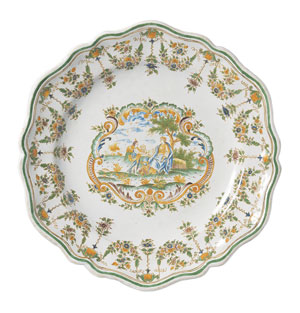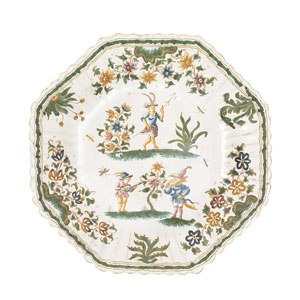Vive la Faience!
Writer Leslie Gilbert ElmanFrench faience ceramics have a colorful history.
In 1689, France was at war with much of Europe and its military was drastically underfunded. So King Louis XIV demanded that the noble classes contribute their silver tableware to be melted down to fund the war effort.
That decree might have supported the national defense, but it left the elite without dishes for the dining table. It also left the door open for France’s enterprising pottery manufactories to make ceramic dinnerware to replace the silver. And that’s what they did.
Louis’s decision turned out to be a boon for the potteries. Nevers in central France, Moustiers-Sainte-Marie in the south and Rouen in the north became thriving centers for manufacturing the hand-painted, tin-glazed earthenware known as faience. Much of this tableware was decorated with the insignias and coats of arms of noble families. After all, the elites might have relinquished their engraved silver services, but they still expected to dine on monogrammed plates.
Faience is French for Faenza, an Italian city famed for its tin-glazed earthenware maiolica pottery. Before French faience became known in its own right, when people in France mentioned “faience” they usually were referring to maiolica from Faenza. (Since 1908, Faenza has been home to the International Museum of Ceramics, the world’s largest repository of historic ceramics. The collection had to be rebuilt after a World War II bombing destroyed it.)
In 1602, the three Concorde brothers from near Savona, Italy, founded the first faience manufactory in Nevers, France. Rival manufactories followed, and the wares evolved into something distinctly, fashionably French, with ornamentation inspired by mythology and allegory, the pastoral and “oriental” patterns of chintz fabrics and wall coverings that were a décor rage in France.
Around 1647, painters and potters from Nevers were recruited to the city of Rouen to build a faience industry there. It wasn’t long before the prolific faience works of Nevers and Rouen were supplying influential clients throughout France, including Louis XIV himself. The whimsical Trianon de Porcelaine he built at Versailles in 1670 as a place for rendezvous with his mistress, Madame de Montespan, was ornamented top to bottom with ceramic tile. (When their affair ended, the Trianon de Porcelaine was demolished—possibly at the demand of the king’s new wife, Madame de Maintenon.)
The first faience manufactory in Moustiers was founded by Pierre Clérissy in the late 17th century (before 1686). Known for the whiteness of its ground and refinement of its figures, the Moustiers style was imitated with varying degrees of success by faience manufactories large and small throughout France. One in Ardus was run by a woman named Louise Pichon around 1752. The global company Villeroy & Boch began in 1748 as a faience company in Audun le Tiche.
Clients with disposable incomes to match their passion for ceramics sometimes hired Moustiers craftsmen to work for them exclusively. The seigneur de Goult engaged artists from Moustiers to staff a faience manufactory in his ancestral castle. In 1727, the Spanish count of Aranda recruited artists from Moustiers for his faience manufactory in Alcora, Spain. One of them, Joseph Olérys, eventually returned to Moustiers and set up the Olérys et Laugier faience business with his brother-in-law, Jean-Baptiste Laugier.
In the 1880s, Moustiers faience was the subject of a different sort of imitation, when newspapers reported widespread counterfeiting of 17th- and 18th-century faience with objects being sold at bric-a-brac stalls in French markets.
From the palace at Versailles to a French flea market? History and fashion can take peculiar turns.
The look and feel of faience is quite distinct from the refined, pure white, hard-paste porcelain produced in Limoges and Sévres beginning in the 18th century. Around the turn of the last century, some art critics decided that this made faience inferior and unworthy of notice. “Old Rouen and Moustiers ware” had “little artistic merit” and was “valuable only for historical study,” they opined. Today’s collectors would strongly disagree. They appreciate faience for its charm and artistry and, of course, for its colorful history.
The objects featured in these photos are from the outstanding Eugene V. and Clare E. Thaw collection of Moustiers ceramics now in the permanent collection of the Cooper Hewitt, Smithsonian Design Museum in New York City.
Cooper Hewitt, Smithsonian Design Museum | cooperhewitt.org
Leslie Gilbert Elman is the author of Weird But True: 200 Astounding, Outrageous and Totally Off the Wall Facts. She writes about antiques and other subjects for Design NJ.





